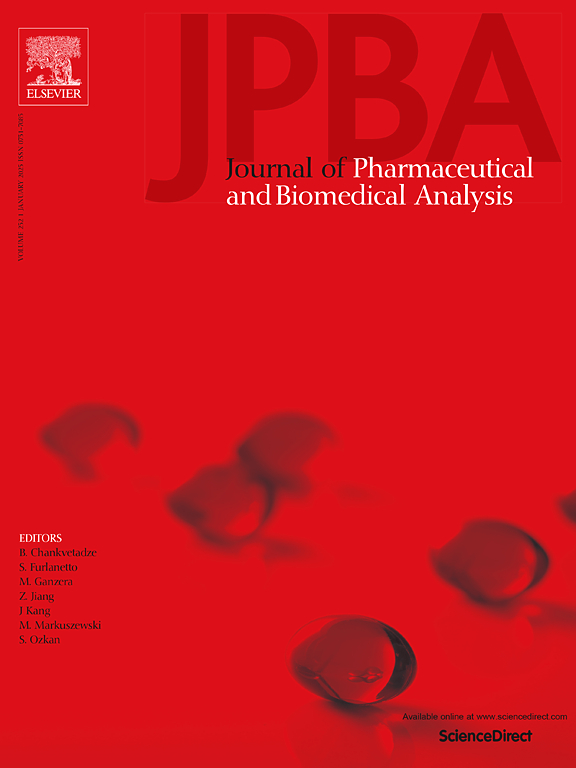Pseudotargeted metabolomics profiles potential damage-associated molecular patterns as machine learning predictors for acute pancreatitis
IF 3.1
3区 医学
Q2 CHEMISTRY, ANALYTICAL
Journal of pharmaceutical and biomedical analysis
Pub Date : 2025-04-07
DOI:10.1016/j.jpba.2025.116874
引用次数: 0
Abstract
Acute pancreatitis (AP) is a common gastrointestinal disease characterized by pancreatic cell damage and inflammation. Given the early clinical diagnosis and management challenges, exploring novel analytical frameworks from new orientations for interrogating AP is urgent. The release of damage-associated molecular patterns (DAMPs) and their receptor recognition initiate sterile inflammation, serving as key drivers in the development and progression of AP. Thus, this study aimed to delineate the underlying correlations between alterations in the DAMP profile and the AP state. We have developed a new framework combining potential DAMPs profiles obtained from pseudotargeted metabolomics method with machine learning (ML) models for AP prediction. 2-(1-Piperazinyl) pyrimidine chemical labeling was utilized to provide characteristic fragment ions and improve the quantitative sensitivity of targeted metabolites. A total of 49 potential DAMPs were identified and semi-quantified from collected serum samples (n = 84), positive or negative for APs. For modeling obtained datasets with five different ML algorithms, the support vector machine model was chosen as the optimal model to differentiate with high accuracy, achieving an area under the receiver-operating characteristic curve (AUROC) of 0.944. It also showed a strong performance in an external independent validation set (AUROC: 0.907). Moreover, the model was interpreted using the Shapley Additive exPlanations analysis to specify the important features and identify specific free fatty acids as key contributors. Overall, the novel framework enables high accuracy in predicting the presence of AP status. Meanwhile, it underlines the utility of DAMPs in inflammatory diseases and provides reference values for diagnosing in first-line clinics.
伪靶向代谢组学描述了潜在的损伤相关分子模式,作为急性胰腺炎的机器学习预测因子
急性胰腺炎(AP)是一种以胰腺细胞损伤和炎症为特征的常见胃肠道疾病。鉴于早期临床诊断和管理方面的挑战,从新的方向探索新的分析框架以研究急性胰腺炎迫在眉睫。损伤相关分子模式(DAMPs)的释放及其受体识别引发了无菌性炎症,是胰腺炎发生和发展的关键驱动因素。因此,本研究旨在阐明 DAMP 特征改变与 AP 状态之间的潜在关联。我们开发了一种新的框架,将从伪靶向代谢组学方法中获得的潜在 DAMPs 图谱与机器学习(ML)模型相结合,用于 AP 预测。我们利用 2-(1-哌嗪基)嘧啶化学标记提供特征碎片离子,提高了靶向代谢物的定量灵敏度。从采集的血清样本(n = 84)中共鉴定和半定量了 49 种潜在的 DAMPs,这些样本对 APs 呈阳性或阴性。在用五种不同的多重参照算法对获得的数据集进行建模时,支持向量机模型被选为最佳模型,其区分准确度高,接收者工作特征曲线下面积(AUROC)达到 0.944。该模型在外部独立验证集(AUROC:0.907)中也表现出很强的性能。此外,还使用 Shapley Additive exPlanations 分析法对模型进行了解释,以明确重要特征,并确定特定的游离脂肪酸是关键因素。总之,新框架能高精度地预测是否存在 AP 状态。同时,它强调了 DAMPs 在炎症性疾病中的实用性,并为一线临床诊断提供了参考值。
本文章由计算机程序翻译,如有差异,请以英文原文为准。
求助全文
约1分钟内获得全文
求助全文
来源期刊
CiteScore
6.70
自引率
5.90%
发文量
588
审稿时长
37 days
期刊介绍:
This journal is an international medium directed towards the needs of academic, clinical, government and industrial analysis by publishing original research reports and critical reviews on pharmaceutical and biomedical analysis. It covers the interdisciplinary aspects of analysis in the pharmaceutical, biomedical and clinical sciences, including developments in analytical methodology, instrumentation, computation and interpretation. Submissions on novel applications focusing on drug purity and stability studies, pharmacokinetics, therapeutic monitoring, metabolic profiling; drug-related aspects of analytical biochemistry and forensic toxicology; quality assurance in the pharmaceutical industry are also welcome.
Studies from areas of well established and poorly selective methods, such as UV-VIS spectrophotometry (including derivative and multi-wavelength measurements), basic electroanalytical (potentiometric, polarographic and voltammetric) methods, fluorimetry, flow-injection analysis, etc. are accepted for publication in exceptional cases only, if a unique and substantial advantage over presently known systems is demonstrated. The same applies to the assay of simple drug formulations by any kind of methods and the determination of drugs in biological samples based merely on spiked samples. Drug purity/stability studies should contain information on the structure elucidation of the impurities/degradants.

 求助内容:
求助内容: 应助结果提醒方式:
应助结果提醒方式:


